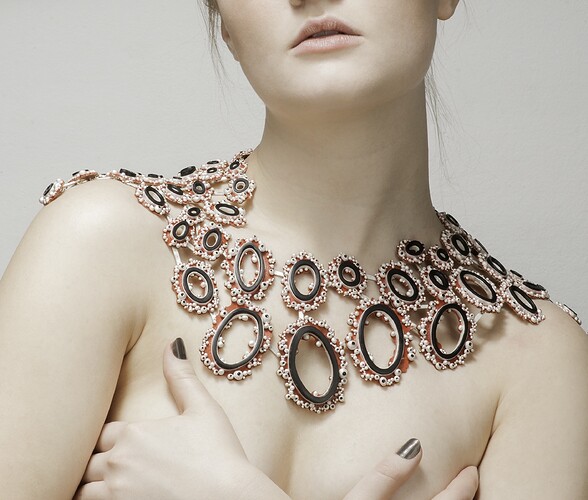Materials: Fine silver, Sterling silver, Copper, Acrylic, Resin, Paint
Dimensions: 7"x 16"x 7"
This necklace is part of a large body of work entitled "Entropy: The breakdown or disorganization of any system." From careful organization to complete disarray, Entropy demonstrates the gradual degradation of a single entity over a period of time. Through the use of multiples, I combined elements of pattern and form from the natural and man-made world. When repeated, these simple forms can become methodical and systematic. When left untended, this organization can disintegrate into natural form that has the potential to invade and overgrow. Within the larger body of work, this necklace represents all that is organized and thought through. The process took seven months of careful preparation and execution. 100 unique links were created, using thousands of individually fused silver granules and series of graphs which organized the entire process. This piece explored an extreme devotion to repetition and organization in a single piece of work.
Photo credit: Mally DePerna
Chelsea Fay
Rochester, NY. USA
Chelsea Fay recently graduated from Rochester Institute of Technology School for American Crafts with a BFA in Metals and Jewelry Design. Using traditional and non-traditional metalsmithing techniques, she is drawn to painstakingly repetitive processes that incorporate line, pattern, and the repetition of form. She has recently taken to experimental granulation as a key component in her work, utilizing the technique in both small and large scale works. Chelsea was a recent Niche Awards Finalist and was recognized as a scholarship winner by the Women’s Jewelry Association and Tiffany & Co Foundation. Her work has been exhibited at the Mobilia Gallery in Boston and has been featured in publications such as The Lapidary Journal and Showcase 500 Art Necklaces.
The exhibition explores metal works whose primary theme is color embraced as their primary visual focus, whether that be using colored materials, exploring creating colored surfaces, or encasing the object in color.
As the world's largest jewelry related internet site, Ganoksin strives to develop exhibitions showcasing work from around the world. This exhibition was open to all metalsmiths, professional and amateur, advanced and beginner.
In total 303 artists contributed 814 show pieces for the permanent online exhibition.
The exhibition was curated by Beth Wicker, President of the North Carolina Society of Goldsmiths in the United States, and Adjunct Instructor at Northeastern Technical College in South Carolina. Director of the exhibition is Hanuman Aspler, founder of The Ganoksin Project, the world's largest internet jewelry site.
Hue is one of the primary properties of color, it refers to the place the color occupies on the visual spectrum. Humans have used hues throughout time, to create cave paintings, to decorate themselves, their clothing and their housing.
Different hues have taken on different meanings throughout time. Gold traditionally has been a color of purity - the metal gold is relatively unchangeable, and the hue of gold has come to stand for gods and goddesses, for royalty, for durability and for purity. Red has often meant love, or passion. Hues often reflect the meaning of the seasons, with pastels referring to spring and the burst of new life after the pale hues of winter. Summer is reflected in vibrant, deep hues, followed by the browning of hues in the fall as plants go to seed and die, and the land turns fallow.
The worth of a hue has often been tied to what is necessary to make the pigment that creates the hue, and the expensive involved in the process. Often created from crushed stones that had to be mined and carried by caravan over thousands of miles, or from fermented roots of plants only grown in certain areas, or the carapaces of rare insects - the creation of hue in a way that could be used by man was an involved and generally expensive process.
In today's world metalsmiths have access to perhaps the widest range of materials and hues in the history of man - and in some of the most affordable ways ever.
This exhibition celebrates hue - color - as an integral, inherent element of the work. We talk of the "richness" of color, and examples of this abound here. One expects hues from the colors of gemstones used in metalsmithing, but we also have hues from some less expected places. Glass enamels are an ancient way of adding color, as are a variety of patinas. Today's artists also use synthetic man-made materials to add color in ways that didn't exist a century ago.
We invite you to enjoy this celebration of hue, and the ways hues and their use have changed over time.
